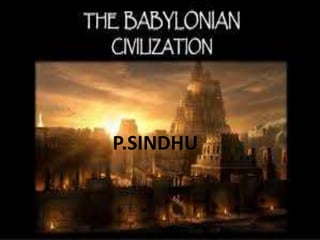Babylonia civilization
•Als PPTX, PDF herunterladen•
1 gefällt mir•1,434 views
Babylonian Civilization
Melden
Teilen
Melden
Teilen

Empfohlen
Weitere ähnliche Inhalte
Was ist angesagt?
Was ist angesagt? (20)
Ähnlich wie Babylonia civilization
Ähnlich wie Babylonia civilization (20)
His 101 chapters 1 2 early civilizations & peoples

His 101 chapters 1 2 early civilizations & peoples
Kürzlich hochgeladen
Kürzlich hochgeladen (20)
HMCS Max Bernays Pre-Deployment Brief (May 2024).pptx

HMCS Max Bernays Pre-Deployment Brief (May 2024).pptx
ICT role in 21st century education and it's challenges.

ICT role in 21st century education and it's challenges.
HMCS Vancouver Pre-Deployment Brief - May 2024 (Web Version).pptx

HMCS Vancouver Pre-Deployment Brief - May 2024 (Web Version).pptx
On National Teacher Day, meet the 2024-25 Kenan Fellows

On National Teacher Day, meet the 2024-25 Kenan Fellows
Kodo Millet PPT made by Ghanshyam bairwa college of Agriculture kumher bhara...

Kodo Millet PPT made by Ghanshyam bairwa college of Agriculture kumher bhara...
This PowerPoint helps students to consider the concept of infinity.

This PowerPoint helps students to consider the concept of infinity.
UGC NET Paper 1 Mathematical Reasoning & Aptitude.pdf

UGC NET Paper 1 Mathematical Reasoning & Aptitude.pdf
Basic Civil Engineering first year Notes- Chapter 4 Building.pptx

Basic Civil Engineering first year Notes- Chapter 4 Building.pptx
Fostering Friendships - Enhancing Social Bonds in the Classroom

Fostering Friendships - Enhancing Social Bonds in the Classroom
Python Notes for mca i year students osmania university.docx

Python Notes for mca i year students osmania university.docx
Exploring_the_Narrative_Style_of_Amitav_Ghoshs_Gun_Island.pptx

Exploring_the_Narrative_Style_of_Amitav_Ghoshs_Gun_Island.pptx
Beyond_Borders_Understanding_Anime_and_Manga_Fandom_A_Comprehensive_Audience_...

Beyond_Borders_Understanding_Anime_and_Manga_Fandom_A_Comprehensive_Audience_...
Babylonia civilization
- 2. Growth of the Civilization • Sumerian civilization declined – invasion of Arabic nomads called Akkadians. • Leader – Sargon I, a great warrior – extended empire – Persian Gulf to the Mediterranean sea. • Akkadian adopted – Sumerian Civilization. • About 2200 BC – Sumerian-Akkadian empire declined.
- 3. • Elamites - Semitic tribe occupied southern parts, whereas Amorites – tribe from Syria occupied north. • Amorites first settled in – Babylon. • Leader – Hammurabi, empire which was founded by Hammurabi – Babylonian. • This civilization developed – village of Babylon, i.e Babylonian civilization.
- 4. Hammurabi • Came to prominence – 2100 BC. • Economically – prosperous. • No scarcity of food. • Weaving of woollen cloths – important industry. • During his rule - happy & prosperous.
- 5. Code of Hammurabi • Greatest achievement – Hammurabi Code of Laws – first law giver of mankind. • Engraved the laws – piece of stone of 8 feet high – written in Akkadian & Amorites. • Top of the stone – Hammurabi received the laws from the Sun god. • First discovered – Susa in 1902.
- 6. • Law applicable to all from the nobles to the slaves. • 285 clauses – divided into four groups – civil code, penal code, commercial code & code of procedure. • Aimed at securing justice to all – especially, poor, widows, orphans & labourers. • Prices of different commodities & wages for different works were fixed.
- 7. Punishments • Punishments – various offences like murder, theft, negligence of duty, cheating, etc. • Old conception of “an eye for an eye & a tooth for a tooth”. • If the son beat his father – his hands amputed. • Similarly, doctor’s hands amputed – negligence of work. • People refined – due to these severe punishments.
- 8. • He regulate the society – code of laws. • Establish a rule of law – instead of personal rule. • All were equal before the law.
- 9. Administration • Able administrator. • 55 clay-tablets containing – orders to some of his officers. • In one tablet – he ordered to collect taxes from poor cultivators. • Another tablet – to clear the Euphrates river after the flood. • Ordered the officer to attend the Sheep-shearing festival. • Punished – bribery.
- 10. Religion • Priests – powerful class & foretell the future – movement of stars & planets. • Development of Astronomy. • Chief God – Marduk.
- 11. • Ishtar – goddess of Love – Greek god- Aphrodite & Roman god – Venus. • Shamash – Sun-god. • Stars – gods.
- 12. Education • There were schools in Babylon – impart education. • 1844 school houses – 55 square feet – discovered. • Students memorize 350 signs. • “He who shall in tablet writing shall shine like the Sun”. – proverb explain the educated held high esteem.
- 13. Art & Architecture • Lacked – art of paintings • No place for sculptures. • Hammurabi – some temples & forts.
- 14. Decline of the Babylonian Civilization • Empire decline – death of Hammurabi. • No powerful successors – people lost their power & vigour. • Taking advantage of the internal confusion – Hittites & Kassites – plundered Babylon.